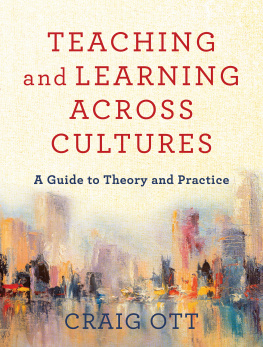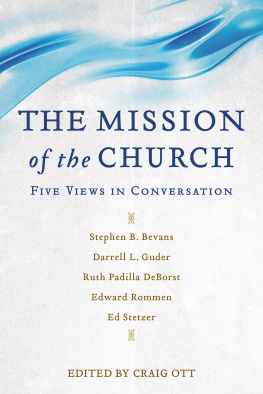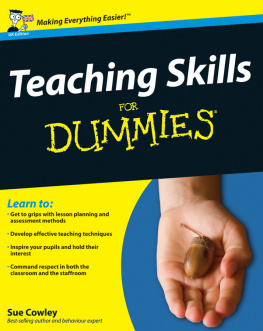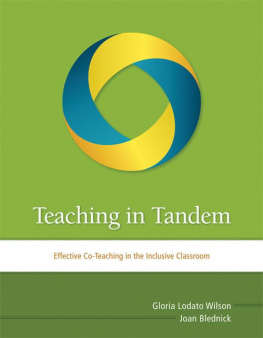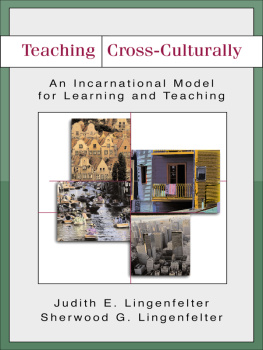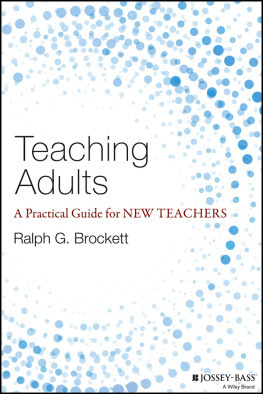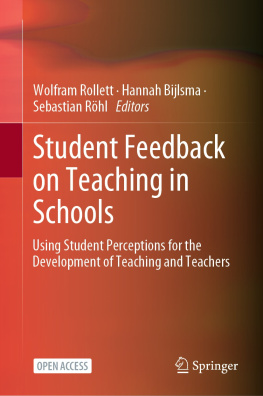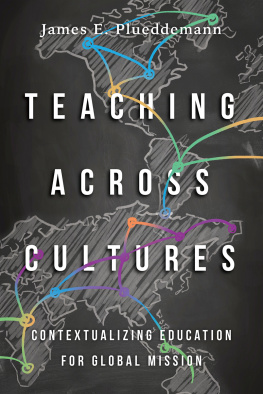Contents
Cover
Half Title Page
Title Page
Copyright Page
Dedication
List of Sidebars
Preface
1. Understanding the Challenge
Who Is the Cross-Cultural Teacher?
The Challenges of Teaching across Cultures
What Does It Mean to Teach and Learn?
Culture and the Content of Teaching
Meeting the Challenge
About This Book
2. Culture and the Teaching Context
What Is Culture?
The Universal, Cultural, and Individual
Culture Change and the Cross-Cultural Teacher
The Dangers of Stereotyping and Ethnocentrism
Developing Intercultural Competency
. Learning Styles, Teaching Styles, and Culture
Learning Styles: A Constructed and Contested Concept
Cultures Influence on Learner Preferences and Expectations
Teaching Styles in International Comparison
Implications for Teaching across Cultures
4. The Cognitive Dimension Part 1: Concrete and Abstract Thinking
What Is a Cognitive Style?
Concrete and Abstract Orientations
Language, Literacy, and Cognition
Concrete Thinking and Critical Analysis
Approaches to Reasoning
Oral and Concrete Features of Biblical Literature
Teaching with Stories
Use of Metaphor and Object Lessons
The Wisdom of Proverbs
Case-Based Instruction
Other Methods and Media
Advantages of Decontextualized, Abstract Teaching
6. The Cognitive Dimension Part 3: Holistic and Analytic Cognitive Styles
Holistic and Analytic Cognitive Styles
Field Dependence and Field Independence
Culture and Field Articulation
Cognitive Development and Culture
Implications for Instruction
Implications for Theological Education
7. The Worldview Dimension Part 1: The Influence of Worldview on Learning
The Nature of a Worldview
Epistemology: How We Know What We Know
Causal Attribution: Why Things Happen
Understanding Time
8. The Worldview Dimension Part 2: Teaching for Worldview Change
Worldview Change and Worldview Changers
Cognitive Approaches
Spiritual Approaches
Communal Approaches
Conclusion
9. The Social Dimension Part 1: The Influence of Social Hierarchy
The Importance of Social Relations for Effective Teaching
The Nature of Status, Hierarchy, and Authority
The Role of Status
Authority and Student-Teacher Interactions
Patron-Client Relationships
From Authority-Based to Critical-Reflective Learning
Characteristics of Individualism and Collectivism
Limitations of the Individualism/Collectivism Construct
The Role of Shame and Honor
Learner Motivation
Social Interactions in Instructional Contexts
Writing Style
Academic Integrity: Plagiarism and Cheating
Conclusion
11. The Media Dimension Part 1: Instructional Methods
Observation and Traditional Learning
Teaching and Learning in a Foreign Language
Reading and Writing Assignments
Lecturing
Use of Visual Media
Song, Drama, and Other Arts
12. The Media Dimension Part 2: Online Learning and Culture
The Hopes and Realities of International Online Education
Advantages of Online Learning in Cross-Cultural Perspective
Limitations of Online Learning in Cross-Cultural Perspective
Addressing the Cultural Challenges of Online Learning
Conclusion
13. The Environmental Dimension
The Physical Environment
The Societal Environment
The Institutional Environment
Works Cited
Index
Back Cover
Sidebars
1.1 Introducing Change
1.2 Resources for Developing a Christian Philosophy of Education in Cultural Perspective
1.3 A Hard-Learned Lesson
1.4 Resources on Biblical Contextualization
2.1 Experience in India
2.2 Resources for Developing Intercultural Competence
4.1 Concrete Thinkers Understanding of Fictional Texts
5.1 Dimming the Stars?
5.2 Training Caregivers through Drama
5.3 Resources for Bible Storying and Oral Learners
5.4 Chronological Bible Storying and Leadership Development
5.5 Carrying the Hound to the Hunt
5.6 A Learning Activity Using Proverbs
5.7 Use of Proverbs in Evangelism
5.8 CHIMES for Oral Learners
6.1 Holistic Learners and Language Learning
6.2 Discerning the Relevant from the Irrelevant
6.3 Teaching Field-Dependent Learners
6.4 Providing Structure for Holistic Learners
6.5 Perceptions of Western Theology in the Majority World
7.2 A Holistic Melanesian Worldview
8.1 Enlightened or Clueless?
8.2 The Power of a Story to Change Society
8.3 A Kenyan Burial Ceremony
9.1 A Question for Miss Yoshikawa
9.2 Exercise: Qualities That Determine a Persons Status in a Society
9.3 The Thai Experience
9.4 Introducing Problem-Based Learning in More Teacher-Centered Learning Contexts
9.5 Learning to Contradict the Teacher
10.1 Hypercompetitive Collectivists? Not an Oxymoron!
10.2 Exercise: From Direct to Indirect Communication
10.3 A Reprimand and a Thirsty Horse
10.4 A Visit to the Ice Cream Parlor
10.5 Blank Stares
10.6 What Is Real Cheating?
10.7 Homework Cartels
10.8 Tips for Teaching Collectivistic Learners
11.1 Maximizing Effectiveness When Teaching through a Translator
11.2 Understanding and Misunderstanding the Jesus Film
11.3 Getting from Here to There
11.4 Story in Song
11.5 Grain Banks, Loan Repayment, and Drama
11.6 The Power of Song and Drama in Public Health Education
12.1 Challenges of International Internet Access
13.1 Teaching and Learning in Under-Resourced Schools
13.2 Resources on Leadership and Culture
Preface
A nyone who has taught students of another culture, or anticipates doing so, knows the challenges they face. But they may be less aware that people from different cultures may approach teaching and learning in fundamentally different ways, which adds an unexpected layer of challenge to the task. Even seasoned teachers often find themselves bewildered by the enigmatic behavior of learners from an unfamiliar culture. This book examines those culturally related differences in teaching and learning, and offers guidance. Whether one is a formal teacher or professor, a community worker or trainer, a pastor or disciple-maker, this book seeks to provide readers with practical insight to understand and navigate those challenges. On the basis of the best cross-cultural research and illustrated with real-life experiences, it will explore ways to appreciate and engage learners from different cultures. It will not suggest cookie-cutter solutions or simplistic how-to guidelines but will point the way to deeper understanding, improved teaching effectiveness, and transformative relationships in the midst of complex intercultural encounters.

